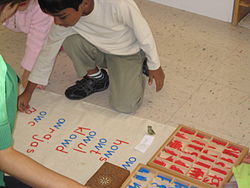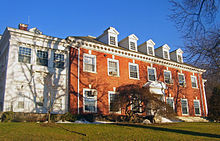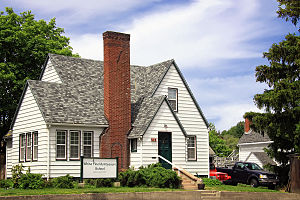
Montessori education
About this schools Wikipedia selection
The articles in this Schools selection have been arranged by curriculum topic thanks to SOS Children volunteers. SOS Children has looked after children in Africa for forty years. Can you help their work in Africa?
Montessori education is an educational approach developed by Italian physician and educator Maria Montessori. Montessori education is practiced in an estimated 30,000 schools worldwide, serving children from birth to eighteen years old.
Montessori education is characterized by an emphasis on independence, freedom within limits, and respect for a child’s natural psychological development, as well as technological advancements in society. Although a range of practices exists under the name "Montessori", the Association Montessori Internationale (AMI) and the American Montessori Society (AMS) cite these elements as essential:
- Mixed age classrooms, with classrooms for children aged 2½ or 3 to 6 years old by far the most common
- Student choice of activity from within a prescribed range of options
- Uninterrupted blocks of work time
- A Constructivist or "discovery" model, where students learn concepts from working with materials, rather than by direct instruction
- Specialized educational materials developed by Montessori and her collaborators
In addition, many Montessori schools design their programs with reference to Montessori’s model of human development from her published works, and use pedagogy, lessons, and materials introduced in teacher training derived from courses presented by Montessori during her lifetime.
History
Maria Montessori began to develop her philosophy and methods in 1897, attending courses in pedagogy at the University of Rome and reading the educational theory of the previous two hundred years. In 1907, she opened her first classroom, the Casa dei Bambini, or Children’s House, in a tenement building in Rome. From the beginning, Montessori based her work on her observations of children and experimentation with the environment, materials, and lessons available to them. She frequently referred to her work as "scientific pedagogy". Montessori education spread to the United States in 1911 and became widely known in education and popular publications. However, conflict between Montessori and the American educational establishment, and especially the publication in 1914 of a critical booklet, The Montessori System Examined by influential education teacher William Heard Kilpatrick, limited the spread of her ideas, and they languished after 1914. Montessori education returned to the United States in 1960 and has since spread to thousands of schools there. Montessori continued to extend her work during her lifetime, developing a comprehensive model of psychological development from birth to age 24, as well as educational approaches for children ages 0 to 3, 3 to 6, and 6 to 12. She wrote and lectured about ages 12 to 18 and beyond, but these programs were not developed during her lifetime.
Montessori education theory
Self-construction12, liberty, and spontaneous activity
Montessori education is fundamentally a model of human development, and an educational approach based on that model. The model has two basic elements. First, children and developing adults engage in psychological self-construction by means of interaction with their environments. Second, children, especially under the age of six, have an innate path of psychological development. Based on her observations, Montessori believed that children at liberty to choose and act freely within an environment prepared according to her model would act spontaneously for optimal development.
Human tendencies
Montessori saw universal, innate characteristics in human psychology which her son and collaborator Mario Montessori identified as "human tendencies" in 1957. There is some debate about the exact list, but the following are clearly identified:
- Self-preservation
- Orientation to the environment
- Order
- Exploration
- Communication
- Work, also described as "purposeful activity"
- Manipulation of the environment
- Exactness
- Repetition
- Abstraction
- The "mathematical mind"
In the Montessori approach, these human tendencies are seen as driving behaviour in every stage of development, and education should respond to and facilitate their expression.
Prepared environment
Montessori's education method called for free activity within a "prepared environment", meaning an educational environment tailored to basic human characteristics and to the specific characteristics of children at different ages. The function of the environment is to allow the child to develop independence in all areas according to his or her inner psychological directives. In addition to offering access to the Montessori materials appropriate to the age of the children, the environment should exhibit the following characteristics:
- Construction in proportion to the child and his/her needs
- Beauty and harmony, cleanliness of environment
- Order
- An arrangement that facilitates movement and activity
- Limitation of materials, so that only material that supports the child's development is included
Planes of development
Montessori observed four distinct periods, or "planes", in human development, extending from birth to six years, from six to twelve, from twelve to eighteen, and from eighteen to twenty-four. She saw different characteristics, learning modes, and developmental imperatives active in each of these planes, and called for educational approaches specific to each period.
First plane
The first plane extends from birth to around six years of age. During this period, Montessori observed that the child undergoes striking physical and psychological development. The first plane child is seen as a concrete, sensorial explorer and learner engaged in the developmental work of psychological self-construction and building functional independence. Montessori introduced several concepts to explain this work, including the absorbent mind, sensitive periods, and normalization.
Absorbent mind: Montessori described the young child's behaviour of effortlessly assimilating the sensorial stimuli of his or her environment, including information from the senses, language, culture, and the development of concepts with the term "absorbent mind". She believed that this is a power unique to the first plane, and that it fades as the child approached age six.
Sensitive periods: Montessori also observed periods of special sensitivity to particular stimuli during this time which she called the "sensitive periods". In Montessori education, the classroom environment responds to these periods by making appropriate materials and activities available while the periods are active in the young child. She identified the following periods and their durations:
- Acquisition of language—from birth to around six years old
- Order—from around one to three years old
- Sensory refinement—from birth to around four years old
- Interest in small objects—from around 18 months to three years old
- Social behaviour—from around two and a half to four years old
Normalization: Finally, Montessori observed in children from three to six years old a psychological state she termed "normalization". Normalization arises from concentration and focus on activity which serves the child’s developmental needs, and is characterized by the ability to concentrate as well as "spontaneous discipline, continuous and happy work, social sentiments of help and sympathy for others."
Second plane
The second plane of development extends from around six to twelve years old. During this period, Montessori observed physical and psychological changes in children, and developed a classroom environment, lessons, and materials, to respond to these new characteristics. Physically, she observed the loss of baby teeth and the lengthening of the legs and torso at the beginning of the plane, and a period of uniform growth following. Psychologically, she observed the "herd instinct", or the tendency to work and socialize in groups, as well as the powers of reason and imagination. Developmentally, she believed the work of the second plane child is the formation of intellectual independence, of moral sense, and of social organization.
Third plane
The third plane of development extends from around twelve to around eighteen years of age, encompassing the period of adolescence. Montessori characterized the third plane by the physical changes of puberty and adolescence, but also psychological changes. She emphasized the psychological instability and difficulties in concentration of this age, as well as the creative tendencies and the development of "a sense of justice and a sense of personal dignity." She used the term "valorization" to describe the adolescents' drive for an externally derived evaluation of their worth. Developmentally, Montessori believed that the work of the third plane child is the construction of the adult self in society.
Fourth plane
The fourth plane of development extends from around eighteen years to around twenty-four years old. Montessori wrote comparatively little about this period and did not develop an educational program for the age. She envisioned young adults prepared by their experiences in Montessori education at the lower levels ready to fully embrace the study of culture and the sciences in order to influence and lead civilization. She believed that economic independence in the form of work for money was critical for this age, and felt that an arbitrary limit to the number of years in university level study was unnecessary, as the study of culture could go on throughout a person's life.
Education and peace
As Montessori developed her theory and practice, she came to believe that education had a role to play in the development of world peace. She felt that children allowed to develop according to their inner laws of development would give rise to a more peaceful and enduring civilization. From the 1930s to the end of her life, she gave a number of lectures and addresses on the subject, saying in 1936,
Preventing conflicts is the work of politics; establishing peace is the work of education.
She received a total of six nominations for the Nobel Peace Prize in a three-year period: 1949, 1950, and 1951.
Montessori education practices
Ages birth to three
Infant and Toddler Programs: Montessori classrooms for children under three fall into several categories, with a number of terms being used. A "Nido", Italian for "nest", serves a small number of children from around two months to around fourteen months, or when the child is confidently walking. A "Young Child Community" serves a larger number of children from around one year to two-and-a-half or three years old. Both environments emphasize materials and activities scaled to the children's size and abilities, opportunities to develop movement, and activities to develop independence. Development of independence in toileting is typically emphasized as well. Some schools also offer "Parent-Infant" classes, in which parents participate with their very young children.
Ages three to six
Preschool and kindergarten Montessori classrooms for children from two-and-a-half or three to six years old are often called Children’s Houses, after Montessori’s first school, the Casa dei Bambini in Rome in 1906. This level is also called "Primary". A typical classroom serves 20 to 30 children in mixed-age groups, staffed by one trained teacher and an assistant. Classrooms are usually outfitted with child-sized tables and chairs arranged singly or in small clusters, with classroom materials on child-height shelves throughout the room. Activities are for the most part initially presented by the teacher, after which they may be chosen more or less freely by the children as interest dictates. Classroom materials usually include activities for engaging in practical skills such as pouring and spooning, materials for the development of the senses, math materials, language materials, music and art materials, and more.
Ages six to twelve
Elementary Classrooms: Classrooms for this age are usually referred to as "Elementary", and can range in size from very small up to 30 or more children, typically staffed by a trained teacher and one or more assistants. Classes usually serve mixed-age six- to nine-year old and nine- to twelve-year old groupings, although six- to twelve-year old groups are also used. Lessons are typically presented to small groups of children, who are then free to follow up with independent work of their own as interest and personal responsibility dictate. The scope of lessons and work in the Elementary classroom is quite broad. Montessori used the term "cosmic education" to indicate both the universal scope of lessons to be presented, and the idea that education in the second plane should help the child realize the human role in the interdependent functioning of the universe. Classroom materials and lessons include work in language, mathematics, history, the sciences, the arts, and much more. Student directed explorations of resources outside the classroom, known as "going out" in Montessori, are an integral element of the Elementary work.
Ages twelve to eighteen
Middle and High School: Montessori education for this level is less well-developed than programs for younger children. Montessori did not establish a teacher training program or a detailed plan of education for adolescents during her lifetime. However, a number of schools have extended their programs for younger children to the middle school and high school levels. In addition, several Montessori organizations have developed teacher training or orientation courses and a loose consensus on the plan of study is emerging. Montessori wrote that,
The essential reform of our plan from this point of view may be defined as follows: during the difficult time of adolescence it is helpful to leave the accustomed environment of the family in town and to go to quiet surroundings in the country, close to nature.
Thus, many Montessori schools for adolescents 12–18 are set in the country, close to nature.
Montessori authenticity
Montessori societies were established internationally to promote the ideas of Maria Montessori. However, Montessori maintained tight control over the use of her name and insisted that only she was able to give authentic training. In 1929, she founded the Association Montessori Internationale (AMI), "to maintain the integrity of her life’s work, and to ensure that it would be perpetuated after her death." AMI continues to train teachers using materials and presentations developed by Montessori and her son, Mario Montessori.
Montessori societies were established in the United States and in several European countries during Montessori's lifetime, but teacher training and authenticity remained under Montessori's control. In 1960, after a dispute with AMI, the American Montessori Society (AMS) was formed. According to AMS, "The two organizations have since reconciled their differences, and now enjoy a collegial relationship of mutual support and respect." AMS trains teachers and states on its website that "AMS is the largest Montessori organization in the world." Other smaller organizations offer training as well, and there is an ongoing controversy in the Montessori world about what constitutes authentic Montessori.
In 1967, the US Patent Trademark Trial and Appeal Board ruled that "the term 'Montessori' has a generic and/or descriptive significance." Therefore, in the United States and elsewhere, the term can be used freely without giving any guarantee of how closely, if at all, a program applies Montessori's work.



